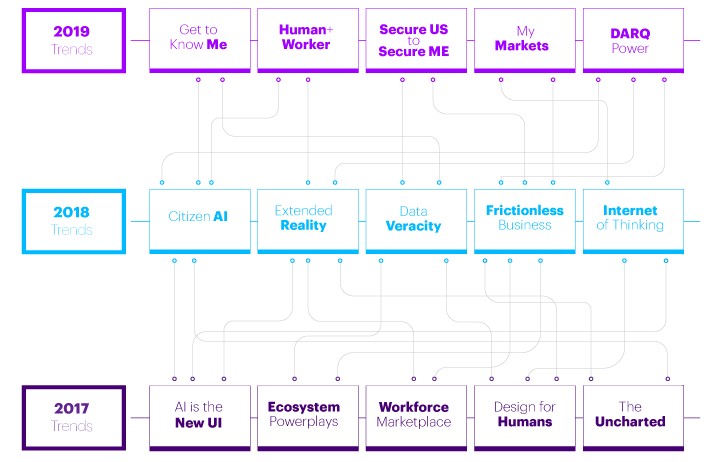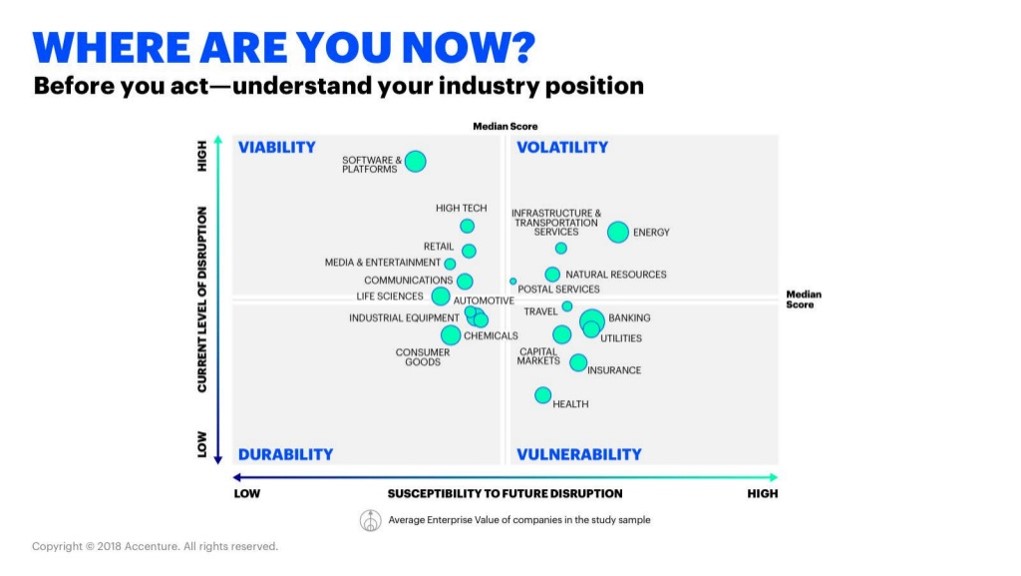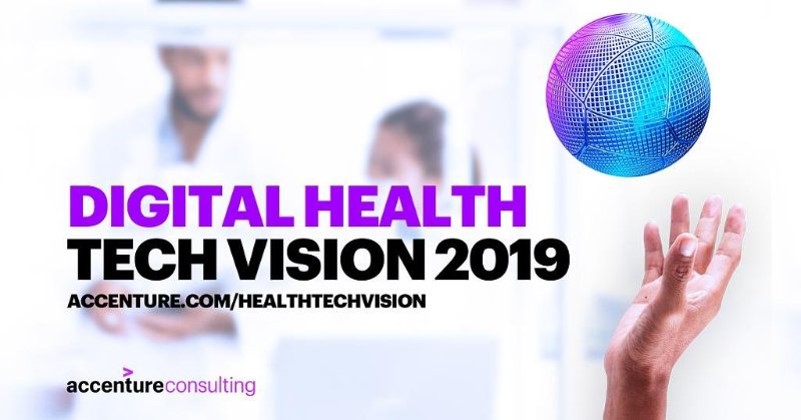 Social, mobile, analytics and the cloud now underpin the health care industry. We’ve been SMAC’ed, and Accenture’s Digital Health Tech Vision 2019 believes we’re in a post-digital era ripe with opportunity.
Social, mobile, analytics and the cloud now underpin the health care industry. We’ve been SMAC’ed, and Accenture’s Digital Health Tech Vision 2019 believes we’re in a post-digital era ripe with opportunity.
Five trends comprise the Vision:
- DARQ Power, the acronym for Distributed ledger technology, Artificial intelligence (AI), extended Reality, and Quantum computing. Adopting these applications can help health care reduce costs, drive labor efficiency and support people-centered design and experience.
- Get to Know Me is the use of technology to develop and deepen relationships with people. As an example of this trend, Accenture points to Mindstrong which leverages AI and machine learning to divine digital phenotypes of consumers-patients that inform mental health support. (For good background on the promise of digital phenotyping for mental health, see this article by Mindstrong’s co-founder Dr. Thomas Insel in World Psychiatry).
- Human +Worker recognizes that workers in organizations are more digitally advanced than the organizations themselves, playing “catch-up” with people. In health care, two-thirds of management told Accenture that in the next three years, staff will have access to a “team of bots” to accomplish their work.
- Secure US to Secure ME calls out the risk of cybersecurity across healthcare organizations’ entire ecosystem of inter-connected payers, providers, technology vendors and, to be sure, patients whose data are a personal precious asset at increasing risk of hacking.
- My Markets is about “meeting consumers’ needs at the speed of now,” in Accenture’s words, because healthcare is more connected in the post-digital age. We live on-demand lives in daily life-flows and tasks, so people expect that experience and service level in health care. The AI part of “SMAQ” is one of the tools the health care industry will increasingly use to personalize, customize, and “immediate-ize” health care across the continuum, from wellness and fitness to acute care and rehabilitation. Underlying technology like the emerging 5G networks, drones, and autonomous vehicles will enable some of the My Markets’ scenario.
 The report points out that the health care industry hasn’t felt the level of disruption that other sectors, shown at the bottom right corner of the company’s “Where Are You Now?” bubble chart of industry positions. The diagram illustrates Accenture’s “Disruptability Index” study published last year. Industries that have already experienced a high degree of disruptions that have been volatile (versus viable) are energy, infrastructure and transportation services, and natural resources. Industries with low current disruption levels that have been durable include consumer goods, industrial equipment, and chemicals.
The report points out that the health care industry hasn’t felt the level of disruption that other sectors, shown at the bottom right corner of the company’s “Where Are You Now?” bubble chart of industry positions. The diagram illustrates Accenture’s “Disruptability Index” study published last year. Industries that have already experienced a high degree of disruptions that have been volatile (versus viable) are energy, infrastructure and transportation services, and natural resources. Industries with low current disruption levels that have been durable include consumer goods, industrial equipment, and chemicals.
Health care sits in the higher vulnerability with low current level of disruption — highly susceptible to future disruption.
Accenture believes that, “Those most vulnerable to disruption are under pressure to scale new technologies….[some] experimenting to learn how these technologies can deliver new sources of value.”
Now return to the first chart to re-visit the five trends, the first four all about the human in health care.

 Health Populi’s Hot Points: “Me,” “US,” My,” pronouns repeat throughout the Accenture 2019 Health Tech Vision report. As I re-read the findings, I kept hearkening back to the George Harrison song, “I Me Mine,” recorded on the Let It Be album — and also the title of Harrison’s (semi-auto) biography. The first stanza of lyrics of “I Me Mine” go:
Health Populi’s Hot Points: “Me,” “US,” My,” pronouns repeat throughout the Accenture 2019 Health Tech Vision report. As I re-read the findings, I kept hearkening back to the George Harrison song, “I Me Mine,” recorded on the Let It Be album — and also the title of Harrison’s (semi-auto) biography. The first stanza of lyrics of “I Me Mine” go:
“All thru the day, I Me Mine I Me Mine I Me Mine
All thru the night, I Me Mine I Me Mine I Me Mine
Now they’re frightened of leaving it
Everyone’s weaving it
Coming on strong all the time
All through the day I Me Mine I Me Mine I Me Mine….”
George could have been writing about the vulnerability of health care organizations late to the digital health era, let alone the post–digital health era. It’s a time for the legacy healthcare system to leap-frog, to turbocharge that scaling of new technologies and experiment, as Accenture recommends at the start of the report. We see such leap-frogging in parts of the world that were indeed late to the Health Care v1.0 era, and now have the opportunity through SMAQ to scale and not be too concerned about sunk investments into slow tech.
“Now they’re frightened of leaving it,” George observed on the third line of the song. Indeed, many healthcare players have been slow to change and pilot, but Accenture’s survey research of health execs demonstrates that most of these folks believe it’s time to get off the dime and embrace that post-digital era.
 I’m particularly keen on the I-Me-Mine analogy as it speaks to the central player in health care I’ve been focusing on for many years: the patient, morphing into the consumer and now, the payor. As I wax on about in my book, HealthConsuming: From Health Consumer to Health Citizen, the new retail health landscape, coupled with digital health platforms (baked into the SMAQ acronym), enables people to take on more self-care, and also connects providers (doctors in traditional settings and new entrants in retail clinics, telehealth channels, and grocery stores, among them) to consumers to inform and support that care.
I’m particularly keen on the I-Me-Mine analogy as it speaks to the central player in health care I’ve been focusing on for many years: the patient, morphing into the consumer and now, the payor. As I wax on about in my book, HealthConsuming: From Health Consumer to Health Citizen, the new retail health landscape, coupled with digital health platforms (baked into the SMAQ acronym), enables people to take on more self-care, and also connects providers (doctors in traditional settings and new entrants in retail clinics, telehealth channels, and grocery stores, among them) to consumers to inform and support that care.
I’m an omnivore of Accenture’s research, and this year’s Digital Health Tech Vision 2019 tells the big top-line truth that, “digital is no longer a differentiator.” There’s no more eHealth or mHealth — it’s all health, it’s all digital.
The great irony in all this — which I, not Accenture, term as ironic — is that “together, humans + machines produce better results.” This is the subtext and subtitle of Dr. Eric Topol’s latest book, Deep Medicine — that AI can and should be artfully deployed to “humanize healthcare.”
Some folks in healthcare may well need that explicit, big “smack” in the head (speaking metaphorically, not literally).





 Thanks to Feedspot for naming this blog, Health Populi, as a
Thanks to Feedspot for naming this blog, Health Populi, as a